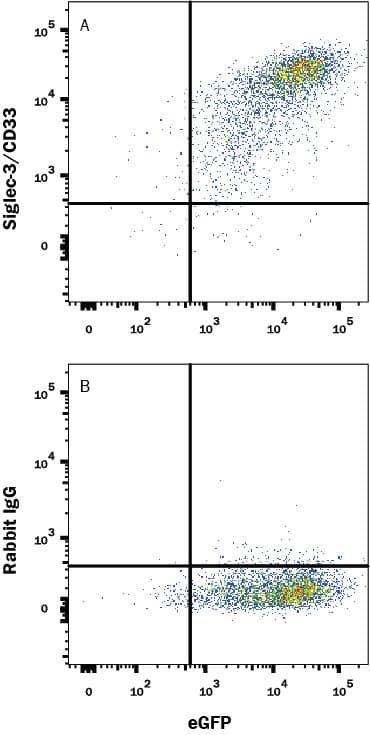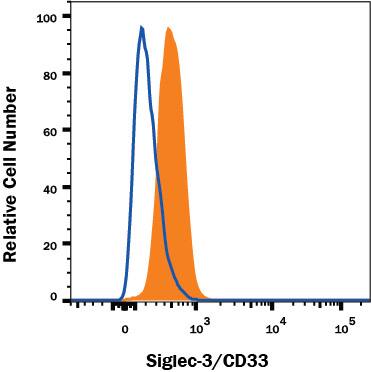Human Siglec-3/CD33 Antibody
R&D Systems, part of Bio-Techne | Catalog # MAB11373
Recombinant Monoclonal Antibody.


Conjugate
Catalog #
Key Product Details
Species Reactivity
Human
Applications
CyTOF-ready, Flow Cytometry
Label
Unconjugated
Antibody Source
Recombinant Monoclonal Rabbit IgG Clone # 2337A
Product Specifications
Immunogen
Mouse myeloma cell line, NS0-derived human Siglec-3/CD33
Asp18-His259
Accession # P20138
Asp18-His259
Accession # P20138
Specificity
Detects human Siglec-3/CD33 in direct ELISAs.
Clonality
Monoclonal
Host
Rabbit
Isotype
IgG
Scientific Data Images for Human Siglec-3/CD33 Antibody
Detection of Siglec-3/CD33 in HEK293 Human Cell Line Transfected with Human Siglec-3/CD33 and eGFP by Flow Cytometry.
HEK293 human embryonic kidney cell line transfected with human Siglec-3/CD33 and eGFP was stained with (A) Rabbit Anti-Human Siglec-3/CD33 Monoclonal Antibody (Catalog # MAB11373) or (B) Rabbit IgG control antibody (Catalog # MAB1050) followed by Allophycocyanin-conjugated Anti-Rabbit IgG Secondary Antibody (Catalog # F0111). View our protocol for Staining Membrane-associated Proteins.Detection of Siglec-3/CD33 on U937 Human Cell Line by Flow Cytometry.
U937 Human histiocytic lymphoma cell line was stained with Rabbit Anti-Human Siglec-3/CD33 Monoclonal Antibody (Catalog # MAB11373, filled histogram) or Rabbit IgG isotype control antibody (Catalog # MAB1050, open histogram) followed by APC-conjugated Anti-Rabbit IgG Secondary Antibody (Catalog # F0111). View our protocol for Staining Membrane-associated Proteins.Applications for Human Siglec-3/CD33 Antibody
Application
Recommended Usage
CyTOF-ready
Ready to be labeled using established conjugation methods. No BSA or other carrier proteins that could interfere with conjugation.
Flow Cytometry
0.25 µg/106 cells
Sample: HEK293 Human Cell Line Transfected with Human Siglec-3/CD33 and eGFP, and U937 Human Cell Line
Sample: HEK293 Human Cell Line Transfected with Human Siglec-3/CD33 and eGFP, and U937 Human Cell Line
Formulation, Preparation, and Storage
Purification
Protein A or G purified from hybridoma culture supernatant
Reconstitution
Reconstitute at 0.5 mg/mL in sterile PBS. For liquid material, refer to CoA for concentration.
Formulation
Lyophilized from a 0.2 μm filtered solution in PBS with Trehalose. *Small pack size (SP) is supplied either lyophilized or as a 0.2 µm filtered solution in PBS.
Shipping
Lyophilized product is shipped at ambient temperature. Liquid small pack size (-SP) is shipped with polar packs. Upon receipt, store immediately at the temperature recommended below.
Stability & Storage
Use a manual defrost freezer and avoid repeated freeze-thaw cycles.
- 12 months from date of receipt, -20 to -70 °C as supplied.
- 1 month, 2 to 8 °C under sterile conditions after reconstitution.
- 6 months, -20 to -70 °C under sterile conditions after reconstitution.
Background: Siglec-3/CD33
Human Siglec-3 is alternatively known as myeloid cell surface antigen CD33 and GP67. Human Siglec-3 cDNA encodes a 364 amino acid (aa) polypeptide with a hydrophobic signal peptide, an N-terminal Ig-like V-type domain, one Ig-like C2-type domains, a transmembrane region and a cytoplasmic tail (1, 4). Siglec-3 expression is restricted to cells of myelomonocytic lineage (2). It binds sialic acid preferring alpha2,3- linkage over alpha2,6- linkage (5). Studies indicated that Siglec-3 recruits SHP-1 and SHP-2 to its ITIMs (6, 7). When co-crosslinking with Fc gammaR1, Siglec-3 inhibits tyrosine phosphorylation and calcium mobilization, suggesting Siglec-3 can mediate inhibitory signals (7).
References
- Crocker, P.R. and A. Varki (2001) Trends Immunol. 22:337.
- Crocker, P.R. and A. Varki (2001) Immunology 103:137.
- Angata, T. et al. (2002) J. Biol. Chem. 277:24466.
- Simmons, D. and B. Seed (1988) J. Immunol. 141:2797.
- Freeman, S.D. et al. (1995) Blood 85:2002.
- Taylor, V.C. et al. (1999) J. Biol. Chem. 274:11505.
- Ulyanova, T. et al. (1999) Eur. J. Immunol. 29:3440.
Long Name
Sialic Acid Binding Ig-like Lectin 3
Alternate Names
CD33, gp67, Siglec3
Gene Symbol
CD33
UniProt
Additional Siglec-3/CD33 Products
Product Documents for Human Siglec-3/CD33 Antibody
Product Specific Notices for Human Siglec-3/CD33 Antibody
For research use only
